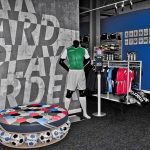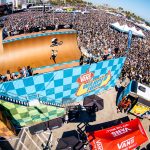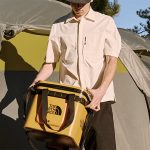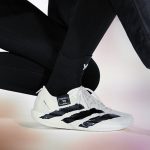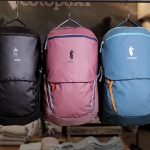Under Armour, Inc. reported third-quarter results that exceeded guidance for the third straight quarter with the help of some recovery in North America. However, Under Armour CEO Kevin Plank declined to predict a return to growth in the region, with the current priority of driving full-price sales.
“Our strategy for reconstituting the Under Armour brand and strengthening our position has primarily focused on North America, our largest and most influential market,” said Plank on a call with analysts. “While this effort impacts the region’s topline, we’re confident that a more disciplined approach to marketplace management, including optimizing our promotional levels, refining our segmentation, and enhancing our premium brand presentation will help restore brand strength in the long run.”
North America Q3 Revenues Sink 8 Percent
Sales in North America revenue decreased 8 percent in the fiscal third quarter ended December 31 to $843.6 million, mainly due to a decrease in its DTC (direct-to-consumer) business due to lower e-commerce sales tied to efforts to limit promotional activities.
The 8 percent decline marked sequential improvement after declining 13 percent in the prior quarter and 12 percent in the same period a year earlier.
Operating income in the region was down slightly, off 1.3 percent to $164.1 million from $166.3 million a year ago.
Discussing the North America region, Plank highlighted the success the brand is finding in reducing the number of promotional days as well as employing “shallower discount depths” online. UA’s e-commerce results in the NA region saw another quarter of average unit retail and average order value growth as well as continued improvement in full-priced sales mix. Said Plank, “Although this has impacted our topline as athletes embrace our evolving value proposition, and you’ve heard me say pricing power, we’re encouraged by the early signs of progress.”
Among its other DTC operations in North America, Plank said Under Armour has “only just started refining and optimizing the promotional strategies” at its factory outlet stores. The focus is on employing a “tiered approach to define each store’s role within its specific market” to better focus on margin contribution. The company has also begun to reduce SKUs to clarify offerings and increase the depth of key products.
Under Armor has similarly reduced SKUs at its full-price Brand House stores to support a “more premium connection” with customers.
Plank said Under Armour’s loyalty program, a key driver of DTC sales, added 4 million members in the quarter to reach 17 million in North America. Plank said members continue to demonstrate higher repurchase rates and revenue per consumer than non-members and the program is expected to be used as another tool to elevate the brand.
Plank said, “We will keep investing and enhancing our loyalty program in every market around the world, ultimately shifting the reason that athletes join our program from being primarily about price to a UA loyalty community that offers exclusivity and membership privileges amongst other things.”
Within the North American wholesale channel, Under Armour is looking to increase its presence at “better” and “best” accounts to complement its positioning within “good” accounts. Plank, who returned to the CEO role in March 2024, expects an improved product lineup by fall/winter 2025 and ramp-up marketing investments will eventually improve demand to drive wholesale growth, but he also cautioned that winning back prime retail space will take time in North America.
“We continue to navigate the effects that several years of elevated promotions and inconsistent execution have had on our order books,” said Plank. “Nevertheless, our strategies to reduce promotional activity in our e-commerce business are encouragingly reducing allowances and markdowns. While it’s clear that getting shelf space back takes time, we’re optimistic that as our product and marketing efforts gain momentum in the coming seasons, this channel will experience a positive shift.”
Under Armour’s beat on both the top and bottom line in the quarter led the company to increase its guidance for the year.
Q3 Sales Review
In the quarter, revenue was down 5.7 percent (6 percent on a currency-neutral basis) to $1.4 billion. The company forecasted revenues to be down approximately 10 percent due to “continued pressure” in North America and efforts to reduce promotional activities in DTC. Sales topped analysts’ average estimate of $1.34 billion.
International revenue decreased 1 percent to $558 million or 2 percent on a currency-neutral basis.
In EMEA, revenue grew 5 percent (up 3 percent currency neutral) to $297.9 million. Growth in its DTC and full-price wholesale business offset a decline in third-party off-price sales. In the Asia-Pacific region, sales were down 5 percent (6 percent currency-neutral) to $201.1 million, reflecting the region’s “highly competitive and promotional landscape,“ according to CFO Dave Bergman. Latin America revenues slumped 16 percent (9 percent currency neutral) to $59.0 million, mainly due to lower distributor sales.
By channel, wholesale revenue dipped 1.0 percent to $705 million as lower sales in the off-price channel were nearly offset by growth in distributor businesses and flat full-price results during the quarter.
DTC revenue was down 9.1 percent to $673 million due to a 20 percent decrease in e-commerce, primarily driven by reduced promotions and discounts across websites. E-commerce represented 39 percent of the total DTC business for the quarter.
Sales at owned retail stores slid 1 percent this quarter. Licensing revenue declined 17.8 percent to $23.9 million, primarily due to the decision to bring its sock business in-house last March.
By product type, apparel revenue was down 5.0 percent to $966.1 million, with softness in most categories partially offset by strength in outdoor and golf. Footwear sales declined 9.0 percent to $301.2 million with most categories decreasing. Accessories grew 5.7 percent to $110,4 million with strength in train and run, partially driven by bringing its socks business in-house.
Gross Margins Top Targets
Gross margins increased 240 basis points to 47.5 percent driven by 100 basis points of supply chain benefits, mainly driven due tolower freight and product costs; 100 basis points due to lower discounting in its DTC business; reduced markdowns at wholesale and slightly more favorable pricing in the off-price channel; 35 basis points gained from favorable foreign currency impacts; and about 10 basis points of benefits from a favorable product mix.
The margin improvement topped a forecast calling for an increase in the range of 150 to 175 basis points due mainly to improved product cost savings, lower freight, and, to a lesser degree, some unplanned currency benefits and lower-than-planned off-price sales.
SG&A expenses increased 6 percent to $638 million, primarily due to increased marketing investments. Adjusted SG&A expenses expanded 5 percent to $606 million, which excludes an impairment of $28 million related to exiting its previous global headquarters and approximately $4 million in transformation expenses related to the fiscal 2025 restructuring program. The adjusted SG&A expense rate was in line with plans.
Operating income was $14 million. Excluding charges, adjusted operating income was $60 million, down 34.8 percent from $92 million a year ago.
Net income in the quarter came to $1 million, or break even, down from $110.8 million, or 25 cents a share, a year ago. Adjusted net income fell 58.3 percent to $35 million, or 8 cents a share, from $84 million, or 19 cents, but topped Under Armour’s prior guidance in the range of 2 cents to 4 cents and Wall Street’s average estimate of 4 cents.
CEO Commentary
In his commentary, Plank highlighted the progress in product development led by Yassine Saidi, who joined the brand in January 2024 after nearly 20 years of experience working at Adidas and Puma.
In footwear, he called out the first signature shoe for Curry Brand athlete De’Aaron Fox, an exclusive at its owned DTC and Dick’s Sporting Goods. Later in February, the Echo, the latest version of UA’s SlipSpeed footwear platform, will arrive ahead of the NBA All-Star weekend.
In apparel, elevated offerings from the brand’s Unstoppable and Meridian collections “have continued to perform well over the past several quarters. So, we’re building confidence that these offerings will help us achieve a better balance in our good-better-best product segmentation,“ said Plank. The UA Icon Heavyweight Hoodie “has seen terrific sell-through,” he added. Publication call-outs include the UA Infinity 2.0 High bra by Women’s Health and UA Project Rock BSR 4 shoe by Men’s Health.
Operationally, a major push has been UA’s move to reduce SKUs across all assortments by 25 percent, including cutting footwear foams by about 50 percent and narrowing its materials library. UA is also transitioning from an apparel, footwear and accessory-led operating model to a category-led operating model around team sports, train, golf, basketball, run, sportswear, outdoor, and other key sports. The shift is expected to align product marketing and commercial teams better and provide greater accountability, led by recently named brand president and former Adidas executive Eric Liedtke.
Plank said, “Key to the benefit of what it will deliver for us is in Eric’s new role leading the brand, which now integrates product and story within the same go-to-market leadership and accountability.”
In marketing, UA is shifting away from performance marketing, which “has led to the promotions that have plagued our recent history,“ to focusing more on “underdog mindset“ messaging with the help of its sponsored athletes and teams. Plank said, “Later this year, we plan to redeploy and centralize a significant amount of our existing marketing budget to fuel our most ambitious brand activation. This dynamic multi-year initiative represents a significant step forward in our marketing approach, specifically designed to resonate with athletes in their environments.”
Asked in the Q&A session where the brand was in its North American reset, Plank said, “We’re in a better position now than we’ve been in years as the turn has begun to start for us with reality like reducing promotions as you’ve seen us do in the channels that we can control. But there’s plenty of opportunity for us to be able to get after. We’re not going to unlock the bottom-line opportunity really with this company until we begin to grow.“
Fiscal 2025 Outlook
- Revenues are now expected to decline by approximately 10 percent compared to the prior expectation of a low double-digit percentage decline.
- North American revenues are expected to decline 12 percent to 13 percent versus the previous expectation of a 14 percent to 16 percent decline.
- International revenues are expected to show a mid-single-digit decrease versus the prior expectation of a low single-digit decline due to softness in Asia. Under Armour expects flat results in the EMEA (no change) and a low-teen percent drop in the Asia-Pacific region compared to the prior expectation of a high single-digit decline.
- Gross margin is expected to increase by approximately 160 basis points, compared to the prior expectation of 125-to-150 basis points. The change is driven primarily by less DTC discounting and lower product and freight costs.
- SG&A expenses are expected to increase at a high-single-digit percentage rate, primarily due to litigation settlement expenses. Excluding these litigation settlement expenses, related insurance recoveries, anticipated transformation expenses, and impairment charges, adjusted SG&A expenses are expected to decrease at a low-single-digit percentage rate versus the prior expectation for a low-to-mid single-digit percentage decline.
- Operating loss is expected to be $179 million to $189 million, compared to the previous expectation of $176 million to $196 million. Excluding the midpoint of anticipated restructuring charges and transformation expenses, litigation settlement expenses and related insurance recoveries and impairment charges, adjusted operating income is expected to be $185 million to $195 million compared to the prior expectation of $165 million to $185 million.
- Diluted loss per share is expected to be 48 cents to 50 cents per share, compared to the prior expectation of 48 cents to 51 cents.
- Adjusted diluted earnings per share is expected to range between 28 cents to 30 cents, compared to the previous expectation of 24 cents to 27 cents.
- Capital expenditures are expected to be $170 million to $180 million, compared to the previous estimate of $190 million to $210 million.
Image courtesy Under Armour






